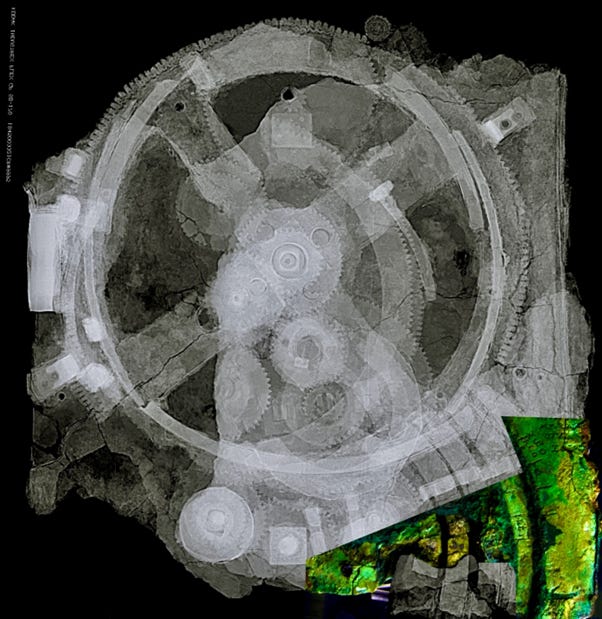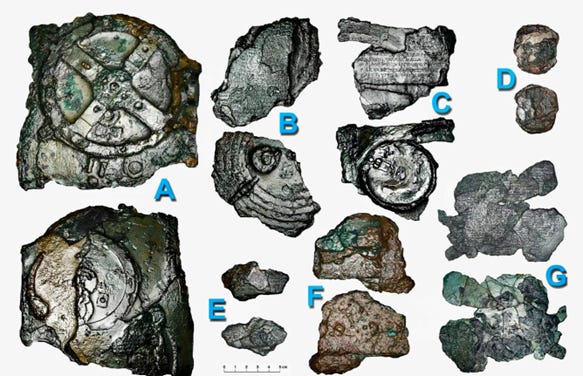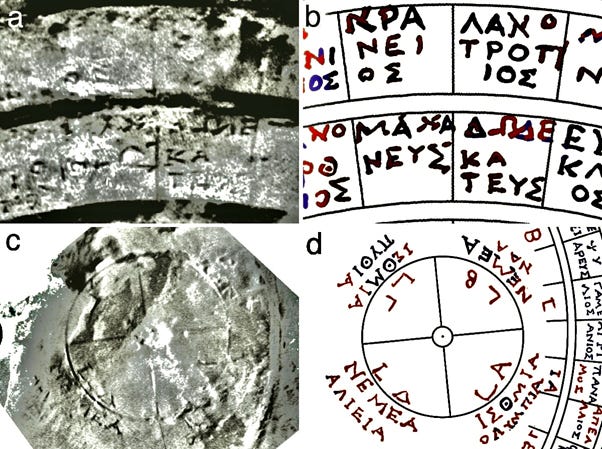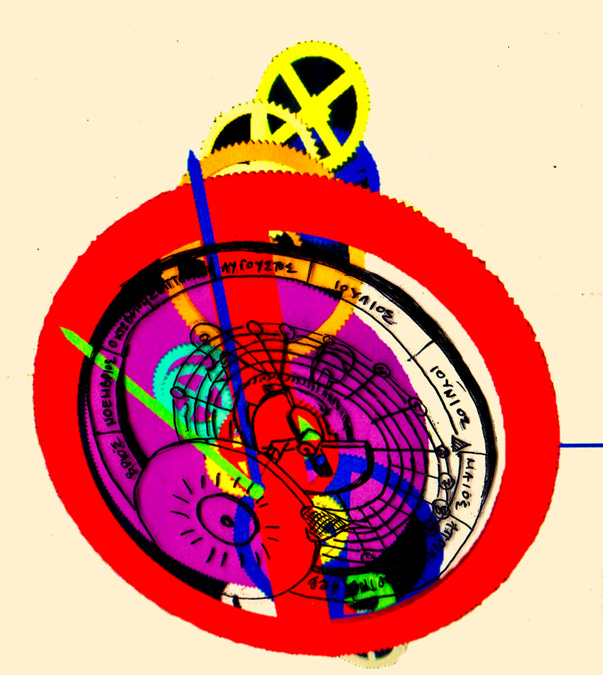The World's First Computer
The Antikythera Mechanism
Dear Classical Wisdom Reader,
I don't know if you're already heard about it.
AI technology has been used to read an ancient scroll from Herculaneum. Despite being preserved in the same eruption of Mt. Vesuvius which destroyed Pompeii, it was so fragile it could not be opened without disintegrating.
The contents of the scroll seemed destined to remain a mystery.
That was until a competition was launched to find a solution. Technology students have utilized AI technology to read the scroll without it being opened.
It's now believed the scroll belonged to Julius Caesar's father-in-law.
It's a cool example of the ways technology and the ancient world can intersect.
Yet it's not the only one...
Despite what we might think, technology is nothing new.
Whether it’s the robot-like automatons of Hephaestus, or the astonishing inventions of Archimedes, technology infused the ancient world.
Even some of Plato's most famous and influential writings, like the tale of the Ring of Gyges or the myth of Atlantis, reflect an awareness of the role technology plays in people's lives, in a way which is strikingly prescient.
So maybe it’s not entirely surprising that the world’s first computer came from ancient Greece.
Read on below to discover this device, known as the Antikythera Mechanism. It baffled scientists for the better part of a century, before it finally gave up its secrets, and revealed technology that was far beyond what was believed possible for its time…
All the best,
Sean Kelly
Managing Editor
Classical Wisdom
The World’s First Computer
by Evaggelos Vallianatos, Ph.D.
For more than a 100 years of scientific investigations, it was an artefact that kept most of its secrets.
That was until 2005, when scientists from Greece, England, Germany, and the United States brought the latest imaging technologies designed to decode the secrets of the mysterious Greek gadget.
It was first salvaged in 1900 from a sunken ship in the waters of the tiny Greek island of Antikythera. The Greek scientists that first examined it in early twentieth century were completely perplexed by its complexity and appearance. They called it the Antikythera Mechanism.
Its bronze toothed gears shocked modern scientists who were under the illusion that gears were a modern invention. But there was more to it than that…
It was the world’s first computer.

The Antikythera computer
The Antikythera Mechanism was a marvel of ancient Greek scientific technology.
In 1974, the British investigator and professor of the history of science at Yale, Derek de Solla Price, described the Antikythera Mechanism as a “singular artifact” that turned out to be “the most enigmatic, most complicated piece of scientific machinery known from antiquity.”[1]

The Antikythera Mechanism is a very small portable device the size of a dictionary. Its front depicted the Cosmos with the Sun god Helios at its center. Pointers depicted the phases of the Moon, and the planets. Two circular zones surrounded the Cosmos. The outside represented the 365 day year and the other on the inside was the Zodiac, the imaginary circle of constellations represented by animals.
The back plate had two spirals. The upper spiral represented the 19-year 235 month Metonic dial. This was an accurate calendar for the most important agricultural, religious, and cultural events of Greece. The lower spiral was the 18-year 223 months eclipses Saros predictive dial. Saros calculated the dates of the eclipses of the Moon and the Sun. These predictions made the computer because the Greeks looked at the Sun and the Moon as gods.
The Antikythera Mechanism also provided the names and schedule for the Panhellenic games: OLYMPIA for the Olympics; NEMEA for the Nemean games; ISTHMIA for the Isthmian games at Korinthos / Corinth; PYTHIA for the Pythian games at Delphi, NAA for games in Dodona in Epiros, and Alieia for games in Rhodes.

The Olympiad Dial of the Antikythera device highlighted the Greeks’ conception of the divine nature of the Cosmos: the celebration of the gods with sports, and the observation of the heavens, the real home of the gods. The scientists in their 2008 report were right in raising the extremely profound issue that: “Is it perhaps not extravagant to see the Mechanism as a microcosm illustrating the temporal harmonization of human and divine order.”[2]
Hipparchos and the Antikythera computer
But where did it come from? Who built it? And, more importantly, why?
In all likelihood, Hipparchos, the greatest Greek astronomer, built the Antikythera computer in the island of Rhodes where, from about 140 to 120 BCE, he had his laboratory. More than other Greek astronomers, he made use of the data of Babylonian astronomers. But like the rest of the Greek astronomers, he employed geometry in the study and understanding of astronomical phenomena. He invented plane trigonometry and made astronomy the predictive mathematical science it is today.
The connection of Hipparchos to the Antikythera Mechanism is in the front bronze plate of the device, where pointers displayed the positions and speed of the Sun and the Moon in the Zodiac. According to the July 2008 report in Nature, that technology mirrored Hipparchos’ studies.[3] Hipparchos knew the moon moved around the Earth at different speeds. When the moon is close to the Earth, it moves faster than when it is farther from the earth when it slows down. This is because the moon’s orbit is elliptical, not the perfect and eternal circular movement the Greeks associated with the stars. Hipparchos resolved this difficulty with his epicyclic lunar theory, which superimposed one circular motion of the moon onto another, the second movement having a different center.

This is reflected in the Antikythera Mechanism itself. This meant one gearwheel sitting on top of another but located on a different axis. A pin-and-slot mechanism, modeling the lunar theory of Hipparchos,[4] takes under consideration the non-circular or elliptical orbit of the moon. A pin originating from the bottom wheel enters the slot of the wheel above it. When the bottom wheel turns, it also drives around the top gearwheel. However, the wheels have different centers and, therefore, the pin slides back and forth in the slot, which enables the speed of the top wheel to vary while that of the bottom wheel remains constant. This is another asset of the advanced technology driving the Greek computer of genius.
The Antikythera Mechanism, the world’s first computer, is ultimately a manifestation of Hipparchos’ knowledge and fascination with the moving heavenly bodies. Pliny the Elder later wrote of Hipparchos that he “left the sky as a legacy to all men – if anyone should be found to claim this inheritance.”[5]
Evaggelos Vallianatos studied ancient and medieval Greek history at the University of Illinois. He earned a Ph.D. in Modern Greek and European history at the University of Wisconsin. He did postdoctoral studies in the history of science at Harvard. He worked on Capitol Hill and the US Environmental Protection Agency. He is the author of hundreds of articles and seven books, including The Antikythera Mechanism: The Story Behind the Genius of the Greek Computer and its Demise (2021)
[1] Derek de Solla Price, Gears from the Greeks: The Antikythera Mechanism, a Calendar Computer from Ca 80 B.C. (Transactions of the American Philosophical Society, 1974), 5.
[2] “Supplementary Information,” 21 in Tony Freeth et al., “Calendars with Olympiad display and eclipse prediction on the Antikythera Mechanism,” Nature, 31 July 2008, 454: 614-617.
[3] “Supplementary Information,” 2-3 (Nature, 31 July 2008).
[4] “Supplementary Information,” 23-26 (Nature, 30 November 2006).
[5] Pliny the Elder, Natural History II.95 (tr. John F. Healy, London: Penguin Books, 1991).



Marvellous though it is, it is better to describe the Antikythera mechanism as a calculator rather than a computer. The boundary is a bit nebulous, but usually a computer can do many different tasks that can be changed under control of a program, A calculator performs fixed tasks - perhaps many different, but fixed, tasks. For anyone interested in how it could have been built, there is set of wonderful videos showing a replica being created with tools that were available 2000 years ago https://www.youtube.com/watch?v=ML4tw_UzqZE&list=PLZioPDnFPNsHnyxfygxA0to4RXv4_jDU2
Can't wait to see the kind of classical secrets that AI will unlock for us! Especially from Pompeii, which is my single favorite archeological site. Very cool article.